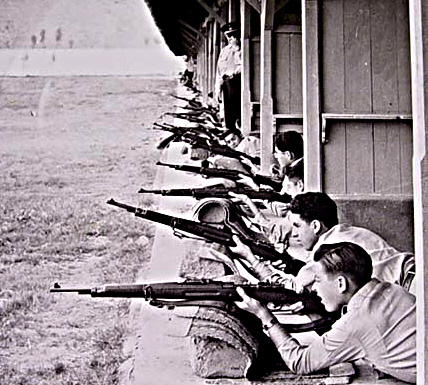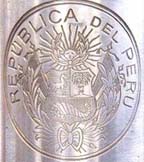By Dan
Reynolds, with the most valued assistance of a private collector who has
provided most of the photos for this article and Antonio Cuba in Peru who
has provided additional information as well as photographs.
In the early 1890's
Peru had various obsolete single shot military rifles in service as well
as smaller numbers of repeating rifles such as the .44-40 Winchester Model
1873, the 11mm M1882 Remington Lee and 7.92mm Reichsgewehr M1888.
In 1901 Peru purchased
the Mauser Modelo Argentino 1891 in
7.65x53mm. Rifles had a 29" barrel, and carbines which were stocked to
the muzzle, with a 17.5" barrel. These were produced by Ludwig Loewe
& Co. in Berlin and were identical with the Mausers being produced
for Argentina in the same period.
I had the opportunity
to examine many of the Argentine contract rifles over 40 years ago and
small improvements were made during the span of production and I would
assume that this may be reflected in Mausers with the Crest of Peru on
the receiver ring, but I cannot say if all change versions observed on
the Argentine Mausers appear among the reported 30,000 Mausers purchased
by Peru. As best as I can recall now, there were five "improved"
versions which progressively appeared during the course of the production
run for Argentina.
The Modelo 1891
was subject to alteration from 1912 after the new Modelo
1909 had entered service in 1910. The M1909 was chambered for
an improved version of the 7.65x53mm using a Spitzer bullet at higher velocity.
Many, but not all rifles and carbines received a new "Lange" type rear
sight calibrated for this cartridge.
In 1909 a new rifle
based on the German Gewehr 1898 Mauser but with some differences was adopted
to supplement the Modelo 1891. It was produced by Mauser and marked
as an "Original Mauser". Both rifles and some carbines were purchased.
Among the differences from the Gewehr 98 are the long cocking piece and
the small barrel shank of the M1891 pattern (this is because Peru specified
that barrels be interchangeable with the small diameter receiver ring of
the Modelo 1891 Mauser and the standard large ring diameter of the Modelo
1909. These rifles were designed to fire the new, improved Spitzer
bullet in the 7.65x53mm case.
These rifles were
beautifully finished but are rarely found in original condition.
In the 1930's, about 1935, Peru purchased a small number of new rifles
from the Mauser in Oberndorf/A.N., made exactly as the originals and so
marked. These were used by ceremonial troops in Lima at the Presidential
Palace up to the late 1950's and were well cared for, retaining all matching
numbers. There exists an unknown quantity of Modelo 1909 rifles which
differ from the common type which is well known to North American collectors.
This variation may be a special type purchased for rifle marksmanship shooting
competition or may be the very earliest production production model.
The highest serial number known is 150. Among the features of these rifles
which set them apart are a special tangent type rear sight which has a
fine adjustment mechanism for elevation (unlike the Lange type rear sight
found on the standard M1909) and a handguard extending from the the receiver
to beyond the lower band. See the photo
for a comparison of these variants.
In the late 1920's
Peru needed to replace worn out and obsolete rifles in military and police
service. In 1919 Peru had purchased replacement barrels in Belgium
for its M1891 and M1909 rifles and was rebuilding them, but with use the
condition of a number of rifles in service declined. The carbine
version of the M1909 was used by the Peruvian Navy in 7.65. In the post
1960 period some of these carbines were presented to high ranking officers
as a retirement gift in a special display box. Officers could buy
a sporterized version with the original barrel rechambered to 7.62x51mm.
In 1930 several
hundred Czech Vz24 Mauser short rifles in 7.65x53mm were purchased from
the Brno rifle works in Moravia. This was followed a few years later
by the Modelo 1932 short rifle and carbine from the same source.
The Modelo 1932 is a very special rifle.
This Mauser uses the special small ring Model 98 pattern action as the
Czech Treasury Police VZ33 Carbine and the German issued G33/40 Carbine
employed by the Mountain Troops of the Wehrmact. It uses an upper
band of a pattern designed to utilize the bayonet for the Modelo 1891.
It is believed that Czech bayonets were made for this rifle, but it may
be that the 5000 thousand rifles were destined for some police unit organization
that was armed with the Modelo 1891 and had spare bayonets of this pattern
on hand. This is speculation. Perhaps some reader has information
on this subject?
F.N. of Herstal
Belgium supplied a rare variation of their M24/30 carbine in 7.65x53mm
sometime in the 1930's. I have only examined one and that was about
45 years ago. It has Crest of Peru, 17.5" barrel, and upper band consists
of a standard F.N M24/30 horizontal "H pattern fitting" applied directly
to the forend wood with no metal cup under it, no bayonet lug, and secured
by a transverse pin as in the first Mauser Standard Modell of 1924 rifles
and carbines. I don't know what the correct Peruvian designation
is for this carbine. There are also Army issued FN Mauser carbines of a
different pattern but I have no information on details. Police issued
Mauser carbines were replaced by the U.S. .30 M1 Carbine.
The next Mauser
rifle to be adopted was the F.N. produced Modelo 1935. This rifle, in 7.65x53mm,
introduced the reversed wing safety. To place on safe you must rotate
it to your left, the exact opposite of all other Mauser military rifles
and carbines known to me. This was done to facilitate a style of marksmanship
popular in the 1930's international and Pan-American military rifle matches
in which the shooter moves his face far forward on the rifle stock to take
his sight picture. It was told to me that a prominent shooting champion
of this period was a Peruvian officer of high rank and he influenced this
change, as when one assumed this shooting position it was possible to be
struck by the normal safety in recoil after firing. Purchases of this model
continued until 1939 and some may have been purchased in the late 1940's.
By the early 1950's
Peru received .30 M1903 American Springfield Rifles (Navy or Armada) and
.30 M1 Garand Rifles (Army). These rifles used the U.S. .30-06 cartridge.
It was decided to convert many worn Mausers to use this cartridge.
Some of the Modelo 1935 rifles were fitted with new barrels and other necessary
parts and given a dull phosphate finish. The receiver bridge was
stamped .30 and the rear center of the receiver was notched while the magazine
was altered to accept the longer .30-06 cartridge (7.62x63mm in metric
designation). Some of the M1909 Mausers were also converted to this
cartridge but this action was not as well suited to the change. FN Modelo
1935 used by the army were rechambered to 7.62x51 beginning in 1959 or
1960. They are currently stored, some being used to arm soldiers
in parades and other ceremonial events. Some are also used in the
shooting matches of the National rifle shooting association but remain the
property of the Peruvian Army and cannot be removed from the army shooting
ranges.
Peru used various
accessories for its Mausers such as bayonets, slings, sight guard/muzzle
caps, and an unusual bolt tool used to facilitate take down of this assembly.
This
page is a work in progress with more information to come. It is prepared
with the assistance of others who have provided valuable information and
photographs.

Students receiving
marksmanship training on 7.65mm Mauser rifles in Peru, 1956".

